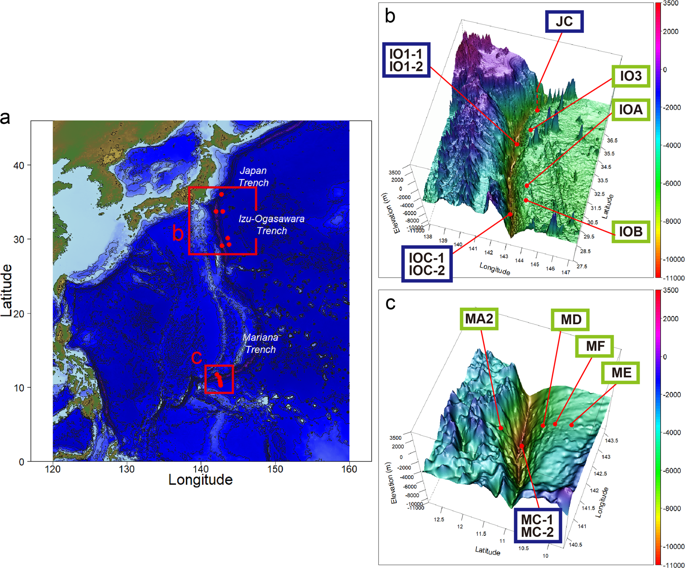Our official English website, www.x-mol.net, welcomes your feedback! (Note: you will need to create a separate account there.)
Microbial community and geochemical analyses of trans-trench sediments for understanding the roles of hadal environments.
The ISME Journal ( IF 11.0 ) Pub Date : 2019-12-11 , DOI: 10.1038/s41396-019-0564-z Satoshi Hiraoka 1 , Miho Hirai 2 , Yohei Matsui 3, 4, 5 , Akiko Makabe 2 , Hiroaki Minegishi 2, 6 , Miwako Tsuda 2 , Juliarni 3 , Eugenio Rastelli 7 , Roberto Danovaro 7, 8 , Cinzia Corinaldesi 9 , Tomo Kitahashi 10 , Eiji Tasumi 2 , Manabu Nishizawa 2 , Ken Takai 2 , Hidetaka Nomaki 2 , Takuro Nunoura 1
The ISME Journal ( IF 11.0 ) Pub Date : 2019-12-11 , DOI: 10.1038/s41396-019-0564-z Satoshi Hiraoka 1 , Miho Hirai 2 , Yohei Matsui 3, 4, 5 , Akiko Makabe 2 , Hiroaki Minegishi 2, 6 , Miwako Tsuda 2 , Juliarni 3 , Eugenio Rastelli 7 , Roberto Danovaro 7, 8 , Cinzia Corinaldesi 9 , Tomo Kitahashi 10 , Eiji Tasumi 2 , Manabu Nishizawa 2 , Ken Takai 2 , Hidetaka Nomaki 2 , Takuro Nunoura 1
Affiliation

|
Hadal trench bottom (>6000 m below sea level) sediments harbor higher microbial cell abundance compared with adjacent abyssal plain sediments. This is supported by the accumulation of sedimentary organic matter (OM), facilitated by trench topography. However, the distribution of benthic microbes in different trench systems has not been well explored yet. Here, we carried out small subunit ribosomal RNA gene tag sequencing for 92 sediment subsamples of seven abyssal and seven hadal sediment cores collected from three trench regions in the northwest Pacific Ocean: the Japan, Izu-Ogasawara, and Mariana Trenches. Tag-sequencing analyses showed specific distribution patterns of several phyla associated with oxygen and nitrate. The community structure was distinct between abyssal and hadal sediments, following geographic locations and factors represented by sediment depth. Co-occurrence network revealed six potential prokaryotic consortia that covaried across regions. Our results further support that the OM cycle is driven by hadal currents and/or rapid burial shapes microbial community structures at trench bottom sites, in addition to vertical deposition from the surface ocean. Our trans-trench analysis highlights intra- and inter-trench distributions of microbial assemblages and geochemistry in surface seafloor sediments, providing novel insights into ultradeep-sea microbial ecology, one of the last frontiers on our planet.
中文翻译:

跨海沟沉积物的微生物群落和地球化学分析,以了解海底环境的作用。
与邻近的深海平原沉积物相比,哈达尔海沟底部(海平面以下> 6000 m)沉积物具有更高的微生物细胞丰度。这得到了沉积有机质 (OM) 积累的支持,这得益于海沟地形的促进。然而,不同海沟系统中底栖微生物的分布尚未得到很好的探索。在这里,我们对从西北太平洋的三个海沟地区(日本、伊豆-小笠原和马里亚纳海沟)收集的 7 个深海和 7 个海底沉积物岩心的 92 个沉积物子样本进行了小亚基核糖体 RNA 基因标记测序。标签测序分析显示了与氧和硝酸盐相关的几个门的特定分布模式。深海和深海沉积物的群落结构不同,以下是沉积物深度所代表的地理位置和因素。共现网络揭示了六个潜在的跨地区共变的原核生物群落。我们的研究结果进一步支持 OM 循环是由深海流和/或沟槽底部的快速埋藏形状微生物群落结构驱动的,此外还有来自表层海洋的垂直沉积。我们的跨海沟分析突出了表层海底沉积物中微生物组合和地球化学的海沟内和海沟间分布,为我们星球上最后的前沿之一超深海微生物生态学提供了新的见解。我们的研究结果进一步支持 OM 循环是由深海流和/或沟槽底部的快速埋藏形状微生物群落结构驱动的,此外还有来自表层海洋的垂直沉积。我们的跨海沟分析突出了表层海底沉积物中微生物组合和地球化学的海沟内和海沟间分布,为我们星球上最后的前沿之一超深海微生物生态学提供了新的见解。我们的研究结果进一步支持 OM 循环是由深海流和/或沟槽底部的快速埋藏形状微生物群落结构驱动的,此外还有来自表层海洋的垂直沉积。我们的跨海沟分析突出了表层海底沉积物中微生物组合和地球化学的海沟内和海沟间分布,为我们星球上最后的前沿之一超深海微生物生态学提供了新的见解。
更新日期:2020-01-17
中文翻译:

跨海沟沉积物的微生物群落和地球化学分析,以了解海底环境的作用。
与邻近的深海平原沉积物相比,哈达尔海沟底部(海平面以下> 6000 m)沉积物具有更高的微生物细胞丰度。这得到了沉积有机质 (OM) 积累的支持,这得益于海沟地形的促进。然而,不同海沟系统中底栖微生物的分布尚未得到很好的探索。在这里,我们对从西北太平洋的三个海沟地区(日本、伊豆-小笠原和马里亚纳海沟)收集的 7 个深海和 7 个海底沉积物岩心的 92 个沉积物子样本进行了小亚基核糖体 RNA 基因标记测序。标签测序分析显示了与氧和硝酸盐相关的几个门的特定分布模式。深海和深海沉积物的群落结构不同,以下是沉积物深度所代表的地理位置和因素。共现网络揭示了六个潜在的跨地区共变的原核生物群落。我们的研究结果进一步支持 OM 循环是由深海流和/或沟槽底部的快速埋藏形状微生物群落结构驱动的,此外还有来自表层海洋的垂直沉积。我们的跨海沟分析突出了表层海底沉积物中微生物组合和地球化学的海沟内和海沟间分布,为我们星球上最后的前沿之一超深海微生物生态学提供了新的见解。我们的研究结果进一步支持 OM 循环是由深海流和/或沟槽底部的快速埋藏形状微生物群落结构驱动的,此外还有来自表层海洋的垂直沉积。我们的跨海沟分析突出了表层海底沉积物中微生物组合和地球化学的海沟内和海沟间分布,为我们星球上最后的前沿之一超深海微生物生态学提供了新的见解。我们的研究结果进一步支持 OM 循环是由深海流和/或沟槽底部的快速埋藏形状微生物群落结构驱动的,此外还有来自表层海洋的垂直沉积。我们的跨海沟分析突出了表层海底沉积物中微生物组合和地球化学的海沟内和海沟间分布,为我们星球上最后的前沿之一超深海微生物生态学提供了新的见解。


























 京公网安备 11010802027423号
京公网安备 11010802027423号